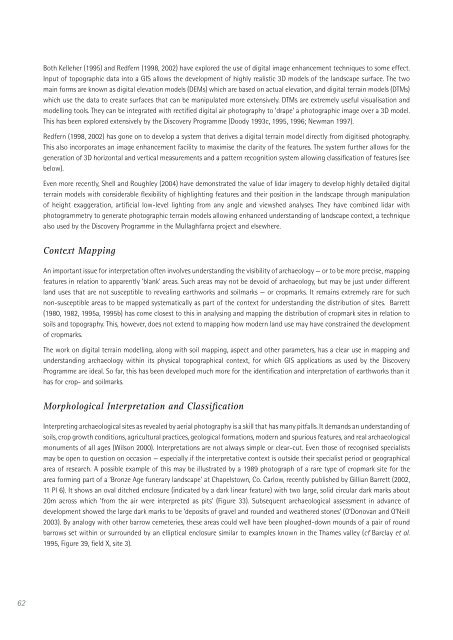Aerial Archaeology in Ireland - The Heritage Council
Aerial Archaeology in Ireland - The Heritage Council
Aerial Archaeology in Ireland - The Heritage Council
You also want an ePaper? Increase the reach of your titles
YUMPU automatically turns print PDFs into web optimized ePapers that Google loves.
62<br />
Both Kelleher (1995) and Redfern (1998, 2002) have explored the use of digital image enhancement techniques to some effect.<br />
Input of topographic data <strong>in</strong>to a GIS allows the development of highly realistic 3D models of the landscape surface. <strong>The</strong> two<br />
ma<strong>in</strong> forms are known as digital elevation models (DEMs) which are based on actual elevation, and digital terra<strong>in</strong> models (DTMs)<br />
which use the data to create surfaces that can be manipulated more extensively. DTMs are extremely useful visualisation and<br />
modell<strong>in</strong>g tools. <strong>The</strong>y can be <strong>in</strong>tegrated with rectified digital air photography to ‘drape’ a photographic image over a 3D model.<br />
This has been explored extensively by the Discovery Programme (Doody 1993c, 1995, 1996; Newman 1997).<br />
Redfern (1998, 2002) has gone on to develop a system that derives a digital terra<strong>in</strong> model directly from digitised photography.<br />
This also <strong>in</strong>corporates an image enhancement facility to maximise the clarity of the features. <strong>The</strong> system further allows for the<br />
generation of 3D horizontal and vertical measurements and a pattern recognition system allow<strong>in</strong>g classification of features (see<br />
below).<br />
Even more recently, Shell and Roughley (2004) have demonstrated the value of lidar imagery to develop highly detailed digital<br />
terra<strong>in</strong> models with considerable flexibility of highlight<strong>in</strong>g features and their position <strong>in</strong> the landscape through manipulation<br />
of height exaggeration, artificial low-level light<strong>in</strong>g from any angle and viewshed analyses. <strong>The</strong>y have comb<strong>in</strong>ed lidar with<br />
photogrammetry to generate photographic terra<strong>in</strong> models allow<strong>in</strong>g enhanced understand<strong>in</strong>g of landscape context, a technique<br />
also used by the Discovery Programme <strong>in</strong> the Mullaghfarna project and elsewhere.<br />
Context Mapp<strong>in</strong>g<br />
An important issue for <strong>in</strong>terpretation often <strong>in</strong>volves understand<strong>in</strong>g the visibility of archaeology — or to be more precise, mapp<strong>in</strong>g<br />
features <strong>in</strong> relation to apparently ‘blank’ areas. Such areas may not be devoid of archaeology, but may be just under different<br />
land uses that are not susceptible to reveal<strong>in</strong>g earthworks and soilmarks — or cropmarks. It rema<strong>in</strong>s extremely rare for such<br />
non-susceptible areas to be mapped systematically as part of the context for understand<strong>in</strong>g the distribution of sites. Barrett<br />
(1980, 1982, 1995a, 1995b) has come closest to this <strong>in</strong> analys<strong>in</strong>g and mapp<strong>in</strong>g the distribution of cropmark sites <strong>in</strong> relation to<br />
soils and topography. This, however, does not extend to mapp<strong>in</strong>g how modern land use may have constra<strong>in</strong>ed the development<br />
of cropmarks.<br />
<strong>The</strong> work on digital terra<strong>in</strong> modell<strong>in</strong>g, along with soil mapp<strong>in</strong>g, aspect and other parameters, has a clear use <strong>in</strong> mapp<strong>in</strong>g and<br />
understand<strong>in</strong>g archaeology with<strong>in</strong> its physical topographical context, for which GIS applications as used by the Discovery<br />
Programme are ideal. So far, this has been developed much more for the identification and <strong>in</strong>terpretation of earthworks than it<br />
has for crop- and soilmarks.<br />
Morphological Interpretation and Classification<br />
Interpret<strong>in</strong>g archaeological sites as revealed by aerial photography is a skill that has many pitfalls. It demands an understand<strong>in</strong>g of<br />
soils, crop growth conditions, agricultural practices, geological formations, modern and spurious features, and real archaeological<br />
monuments of all ages (Wilson 2000). Interpretations are not always simple or clear-cut. Even those of recognised specialists<br />
may be open to question on occasion — especially if the <strong>in</strong>terpretative context is outside their specialist period or geographical<br />
area of research. A possible example of this may be illustrated by a 1989 photograph of a rare type of cropmark site for the<br />
area form<strong>in</strong>g part of a ‘Bronze Age funerary landscape’ at Chapelstown, Co. Carlow, recently published by Gillian Barrett (2002,<br />
11 Pl 6). It shows an oval ditched enclosure (<strong>in</strong>dicated by a dark l<strong>in</strong>ear feature) with two large, solid circular dark marks about<br />
20m across which ‘from the air were <strong>in</strong>terpreted as pits’ (Figure 33). Subsequent archaeological assessment <strong>in</strong> advance of<br />
development showed the large dark marks to be ‘deposits of gravel and rounded and weathered stones’ (O’Donovan and O’Neill<br />
2003). By analogy with other barrow cemeteries, these areas could well have been ploughed-down mounds of a pair of round<br />
barrows set with<strong>in</strong> or surrounded by an elliptical enclosure similar to examples known <strong>in</strong> the Thames valley (cf Barclay et al.<br />
1995, Figure 39, field X, site 3).

















